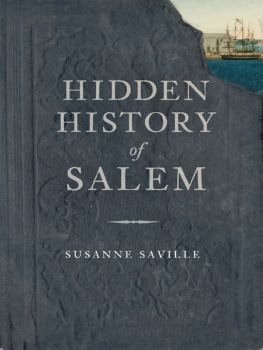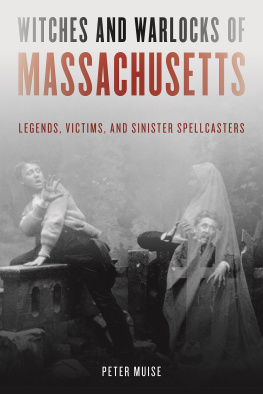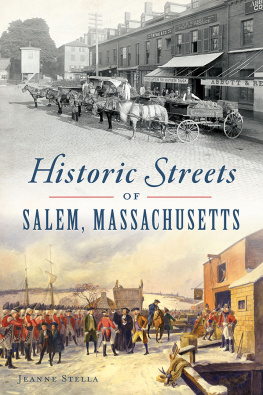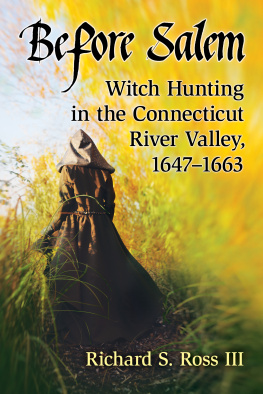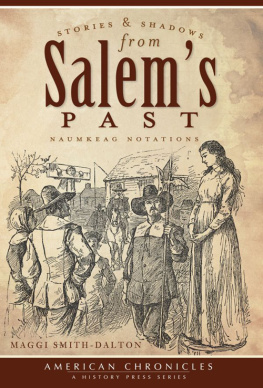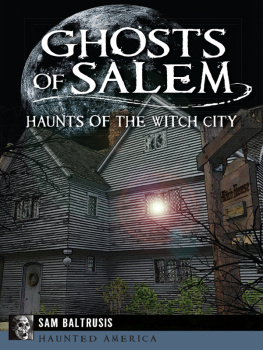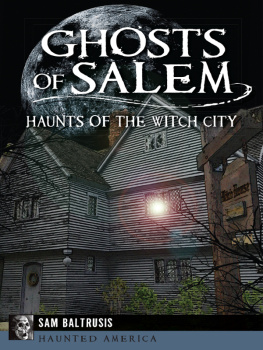

Published by The History Press
Charleston, SC 29403
www.historypress.net
Copyright 2010 by Susanne Saville
All rights reserved
Front cover: Crowninshields Wharf, detail, 1806. Courtesy of the Peabody Essex Museum, Salem, Massachusetts.
All images are from the authors collection unless otherwise noted.
First published 2010
e-book edition 2012
ISBN 978.1.61423.790.7
Library of Congress Cataloging-in-Publication Data
Saville, Susanne.
Hidden history of Salem / Susanne Saville.
p. cm.
Includes bibliographical references.
print edition ISBN 978-1-59629-062-4
1. Salem (Mass.)--History. 2. Salem (Mass.)--Biography. I. Title.
F74.S1S38 2010
974.45--dc22
2010034790
Notice: The information in this book is true and complete to the best of our knowledge. It is offered without guarantee on the part of the author or The History Press. The author and The History Press disclaim all liability in connection with the use of this book.
All rights reserved. No part of this book may be reproduced or transmitted in any form whatsoever without prior written permission from the publisher except in the case of brief quotations embodied in critical articles and reviews.
No son of Salem, wander where he may, will be called to blush at the mention of her past. Come what may, there is only pride and inspiration in recalling that. Come what may, be she a laggard or a leader in the race, her history will never lack a quickening zest.
Robert S. Rantoul
CONTENTS
ENSORCELLED SALEM
Into the land and atmosphere of Witches
Salem is synonymous with witches. Theres just no getting around that. Historically, the city has tried. Campaigns emphasizing its maritime past, its lovely coast and its collection of Asian export art have all jostled for visitors attention, with not one word included about 1692. Some people actually seem to have believed that if Salem toiled hard enough, the witch trials would be forgotten.
Yet somehow, despite the lack of any central monument to the event, that scab on Salems memory refused to heal and disappear. So at the 200th anniversary of the witch trials, members of the Essex Institute decided, why not embrace it? They suggested a memorial lookout tower on Gallows Hill. The plan described a rough-faced stone tower, forty-five feet high with a twenty-foot square base and an internal staircase. Upon climbing to the top, one would be gifted with a scenic view of the surrounding countryside and the ocean. Their argument for the monument ran thus:
The belief in witchcraft, and the death-dealing methods by which it was sought to eradicate it, is a part of the history of the world. Salem witchcrafthas become the most popularly known outbreak of any age or in any land. It will never be forgotten for it never can be. Annually thousands of persons flock to Salem to stand upon the sites made memorable by the occurrences of the witchcraft epoch. It is to set right the minds of these visitors and to instruct them, and the members of our own community as well, in the lessons to be learned from the history of the delusion of 1692 that the Institute seeks to erect this memorial tower.

Pioneer Village, Salem. Courtesy of Library of Congress, HABS MA-1315-1.
This scheme was met with resistance from those who thought such a monument would only perpetuate the association of Salem with witch atrocities. How can you expect people to forget if theres a great big stone tower in the way? The whole affair ought to be cast into oblivion as too horrible to contemplate; a shame on Salem and our community. So the monument was shelved, and Salem went on with the laborious task of trying to make the world forget.
The world proved to be rather recalcitrant. The next hundred years only scrawled Salems association with witches more indelibly into the popular consciousness. To begin with, Daniel Low, a local jeweler, started offering a Salem Witch Souvenir Spoon designed by his son, Seth F. Low, on October 1, 1890.

The Witch House, residence of Judge Jonathan Corwin. Patrick Stanbro, www.patrickstanbro.com.
The issuing of souvenir spoons began about 1851 with the Crystal Palace Exhibition in London. American travelers started bringing them home, and collecting such spoons grew to become a turn-of-the-century fad. The Lows, along with M.W. Galt of Washington, D.C., are primarily responsible for this. Their souvenir spoons were so successful that they inspired the industry to take root in America. You can still find souvenir spoons at tourist destinations across the United States today.
Lows first pattern witch spoon consisted of the word Salem with a witch and three pins on its handle. He immediately received orders from all over the world. Encouraged, his second pattern was even more elaborate. This time the handle was decorated with a cat, a broom, a rope (hanging), pins, a moon and a witch. And engraved in the bowl of the spoon were the date and place. On January 13, 1891, Low registered his Witch trademark and then proceeded to produce the first souvenir catalogue, full of Salem Witch silver.

Early colonial interior. Courtesy of Library of Congress, HABS MASS,5-SAL,20-9.
People who came to Salem and picked up a spoon clamored to make a physical connection with something dating to the witch times. Despite being somewhat hidden behind a Victorian apothecary, witch trial Judge Jonathan Corwins house (the Witch House) attracted enough visitors for its owner Jesse Upton to give tours.
Hoping to redirect this need to see history, Salem created its Pioneer Village. This was one of the very first historical theme parks in the United States, complete with costumed reenactors. It was carefully set in 1630, of course. (Forget, world, forget!) Not that the general public would bother to split that hair.
Then there are the beauty products. Witch Cream, trademarked by C.H. & J. Price of Salem and first available in 1892, was a delightful skin lotion that would restore beauty and freshness to the skin for men, women and babies. Indeed, as well as being soothing, nourishing and healing, the advertising copy promised that Witch Cream could take care of frostbite, sunburn, eczema, pimples, wrinkles, prickly heat and salt rheum. This wondrous product was still selling as late as 1953.
The year 1937 saw the creation of Early American Old Spice, a line of toiletries for women. About 1940, the company ran an advertisement with an illustration of a beautiful woman clad in a simple gown hanging by a thick noose from a gnarled tree, her long dark hair discreetly covering her face and a rose clasped in one of her dangling hands. Beneath this image were the words:
HUNG! as a witch
Much too much for the Puritans of Salem
Her charming witchery quite overcame them,
Enchantress of Satan, they said, Ah me!
And hung the lass to a sycamore tree
Next page
